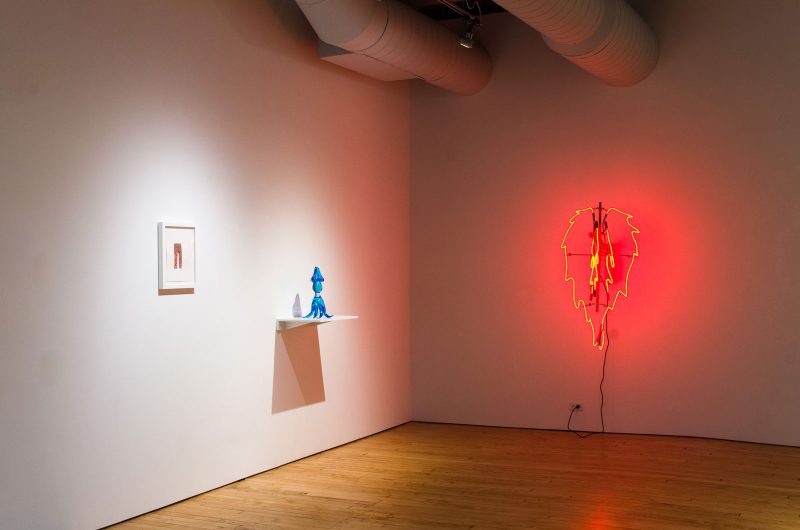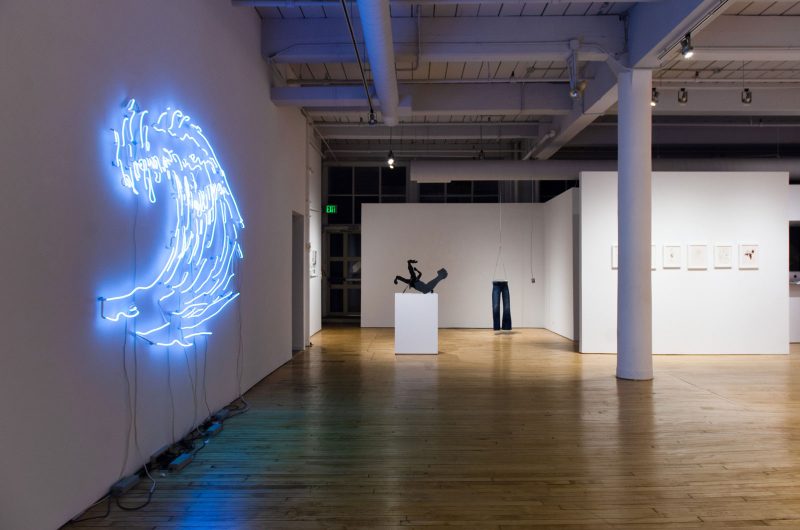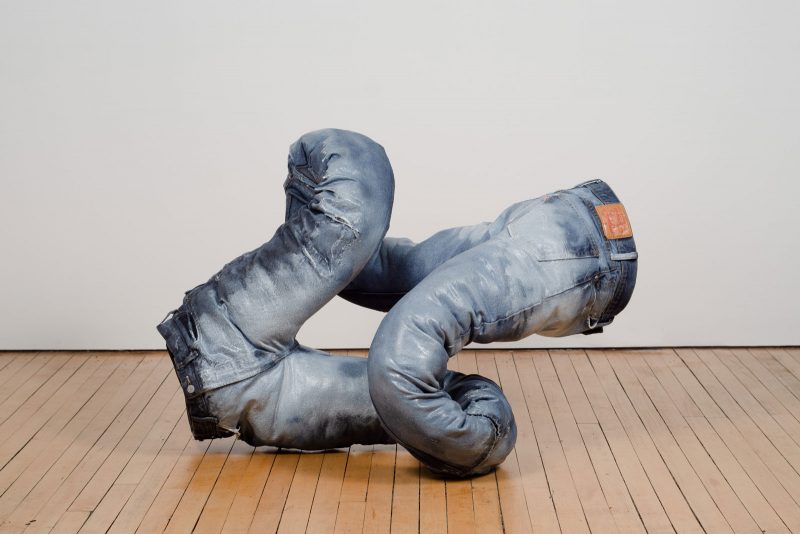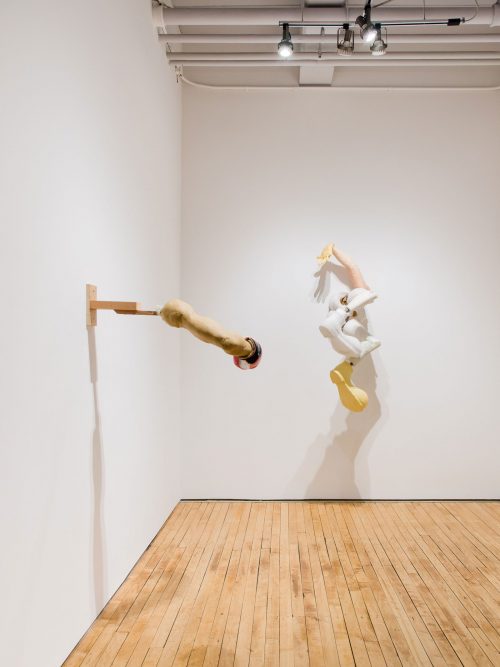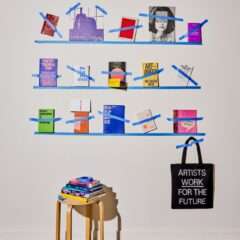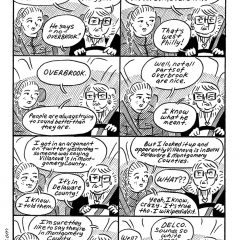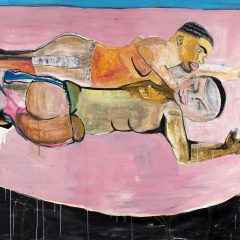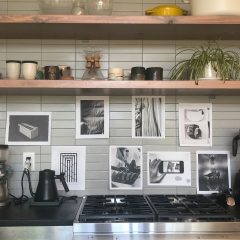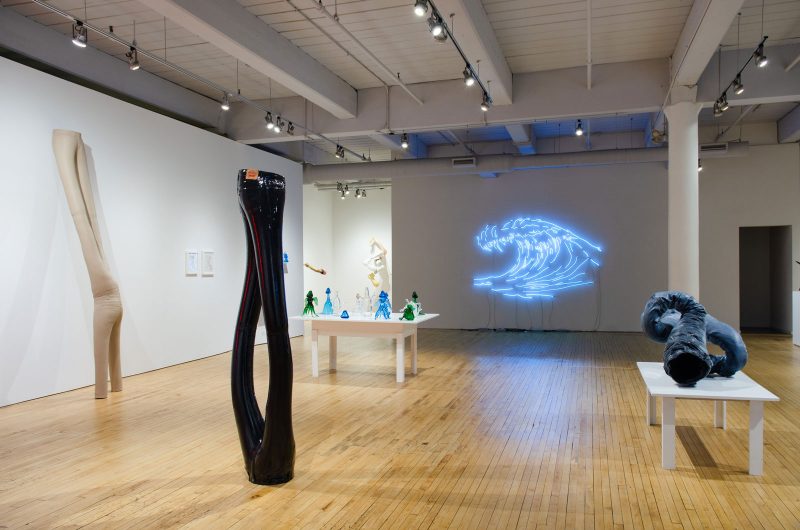
Tristin Lowe has been exhibiting in Philadelphia and points far beyond for more than 25 years. He’s been on a particular roll in recent years, creating individual works of art and presenting installations and exhibitions that roil with Lowe’s wholly characteristic, well-established, and seemingly limitless ability to make folks laugh—and think and, possibly, cry. Lowe is a master of the absurd, but his work is also affecting—it courses with his care for and concern about humanity as a mass and as individuals. For Lowe, laughter is a working cure—or, at least, a salve that both smooths and sparks—for what ails him and everyone. Hard as he might try and hope, his art can’t heal our broken politics, festering social ills, and suffering environment. But, in highlighting our humanity—the dignity and pratfalls that abound in our inborn drive to try and try again, despite failing again and again—he heartens us and encourages us to keep trying.
In the midst of his exhibition Tiny Bangs at Fleisher/Ollman Gallery (through June 1), his installation in the group-show Emanation at the Wheaton Arts and Cultural Center (through December 31), and the whirlwind of life as a working artist, father, husband, and fully engaged human, Lowe shared two hours of conversation with me. The following is, I hope, the edited and condensed essence of thoughts shared about Tiny Bangs and Emanation.
Matt Singer: Thanks to Artblog, I had the opportunity to ponder and write about your 2018 installation Maelstrom Analytica, organized by Mount Airy Contemporary. I was all but literally bowled over by the larger-than-life sculpture, which looked like a Looney-Tunes brawl writ very large and in 3D. What inspired it?
Tristin Lowe: The “dust-up” is not a singular thing for me. Ideas for pieces sometimes take a while. Things need to get kicked around—cross-pollinate, intermingle, ferment. In part, it came from many years of thinking about and taking photos of actual clouds. And I’ve been thinking about glaciers that have been locked up in a solid state for thousands of years—frozen—but now are moving into other, often incredibly volatile states: evaporation, clouds, and rain, but also violent storms and rising, threatening seas. That alchemical transformation from one state to another—that energy—is an element of the Maelstrom subject and took shape previously in my work, and continue to evolve, as impact craters on the moon, neon comets, waves, a car collision, and—most recently—this “dust-up.” It’s “fight or flight” and a raw energy—the dust-cloud mimics the atomic structure of an atom, of the evolution of a star from cosmic dust. It also reflects my thinking about time, about waiting through the stillness before the storm…or a storm that never comes, like Waiting for Godot.
The title Maelstrom Analytica was taken from Cambridge Analytica and about how they, and others, tried and are trying to incite tension and violence and aggressive behavior and division through Twitter and other social-media platforms—all of our new, impersonal ways of communicating. So Maelstrom Analytica and its fellow dust-ups are also expressions of frustration with the hypermasculinity and misogyny of the current political environment, which is dominated by testosterone. Testosterone can screw up your brain in terms of rational thinking and problem solving. Nathaniel Hawthorne talked about how women create life and men, perhaps because of some feeling of inadequacy, control it and ultimately destroy it.
MS: I saw a critique of “toxic masculinity” in Maelstrom Analytica and in the brawling works in Tiny Bangs and Emanation. Is that part of the equation?
TL: I don’t think being male needs to mean being aggro. But we have a president who’s kissing the feet and praising all of these dictators who are doing horrible things all around the world. He’s using his microphone to support tyranny, male-dominant aggro, pissing on everything. I don’t feel as though I’m helping—I’m just getting angry. There’s a bit of that broader aggro and my own anger in the work—the cartoon dust-up, “when push comes to shove,” fisticuffs, trying to solve issues through war.
There’s also this sense of entitlement to own and possess things like the ecosystem and exploit and destroy it. We seem to have regressed from what this country seemed slowly moving toward.
A lot of it is politics, and I don’t know how to make political art—all I can do is use the tools that are available to me. I try to interject some humor, the absurdity, the “cartoonishness,” the buffoonery—and the feeling of not being able to wrap your head around everything that’s happening. I don’t want it to be preachy. It needs to operate on different levels.
MS: Brawling aside, Tiny Bangs seems to explore and express energy, how it’s expended and what it creates—or destroys. Has the focus of the maelstrom shifted a bit since Analytica?
TL: For years—my entire life, it seems—I’ve been thinking about the Big Bang and the wonderment of this Garden of Eden we call Earth. We’ve advanced and looking further into the universe and farther away from thinking of ourselves as the center of the universe—now, in fact, we know and can see in photographs that there’s actually a supermassive Black Hole at the center of each galaxy.
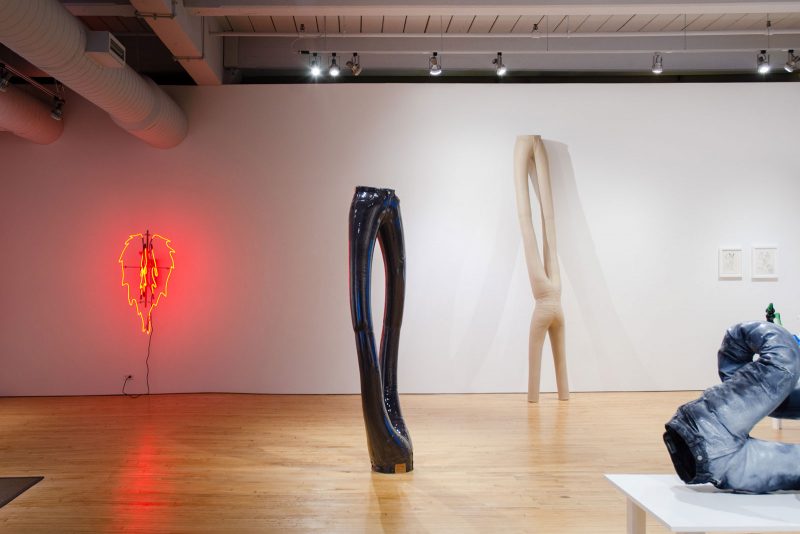
MS: Beside the relatively new maelstrom subject, your new work revisits shapes and subjects and motifs from your earlier work—some extend back to the 1990s. They feel very much reinvented. How?
TL: All of these things I revisit—jeans, genomes, clowns, Theater of the Absurd, humor, Hawthorne, Melville—I’m not an expert in them. I just feel a connection to them and revisit them, each time garnering from the insights I gained in making the previous piece about them and, hopefully, bringing something new to the equation. The idea is to get closer to an essence.
The bottles, the wings, the noses in Tiny Bangs—they are guiding spirits, in a way. Revisiting them is revisiting ideas, characters, and choices that have led a path. Following your fascinations and curiosities allows you to find something you didn’t know and to be surprised.
MS: In your new work some of the brawling shapes have an element not seen in Maelstrom Analytica—angel wings. How did they land here?
TL: It happened for me at a bar mitzvah in Minnesota. Merrick—the boy becoming bar mitzvah—did an awesome job reciting and interpreting the story of Jacob wrestling with the angel. It connected with the wings of the clown-slash-muse-slash-trickster that has been a character in my work for many years. And it’s like a lot of the old cartoons we saw as kids where there would be a good angel standing on one shoulder and the devil on the other, which was a stand-in for battling with yourself: the battle of conscience and figuring out what’s right and wrong—something that’s lacking in the current administration.
Wrestling with an angel and wrestling with yourself are the same thing. It’s only by wrestling with your flaws and your foibles—your humanity—that you can come to know and appreciate yourself. I’m not there yet. Maybe I’ve glimpsed through the keyhole but I don’t walk with the angels [laughs].
The introduction of wings to the Maelstrom has the association with the concept of enlightenment. I used rockets and monorails earlier in my work— flight can be a metaphor for transcendence. It’s also using the humor of the clown—for me, clowns have wings—to say you don’t have to follow the path that everyone else has gone, that you can get to the mountain by going another way. Or maybe you don’t have to go to the mountain at all.
My concept of God or a messenger of God is something from above, but not literally. It’s a metaphor for enlightenment and aspirations, the things that we strive to be. To be in awe. At the risk of sounding pompous, I hope Tiny Bangs breeds a sense of awe. That it lifts, encourages, helps people to breathe deeper and feel like kids again, that everything is possible—that you can fly. That’s what it is with the tiny bangs of our lives—they can encourage a potential, a feeling, an appreciation of the moment.
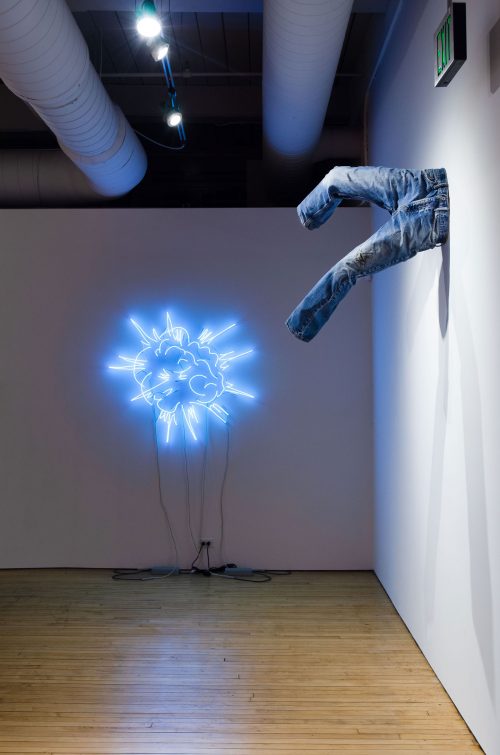
MS: You’ve worked in and with denim for years. What attracts you to it?—and what are the jeans doing in Tiny Bangs?
TL: They’re a very American thing. We grew up with them. It’s the fabric of our country [laughs]. It’s an everyman thing. And using the lower half of the body relates to sex and the primal parts of ourselves. It’s a self-portrait and a stand-in for ourselves—without our jeans we’re the naked ape.
I use the jeans to sort of draw mathematical or scientific symbols like the infinity sign or the double-helix of DNA. It’s like making diagrams to describe the most complicated and abstract scientific thought, but with jeans that are worn in and forever retain the impression and shape of our very human and very real, struggling, vulnerable bodies.
MS: You often included kinetic works in your shows—clowns that flew on monorails, plastic giants that inflated and deflated, beds that wet themselves. That kinetic element returns in Tiny Bangs.
TL: By making art move it becomes ephemeral, like experiencing music or an event or a happening—it lives on in memory rather than matter. Especially because the nature of using something motorized, like the fan in Happy Pants, is that it’s using moving parts and moving parts wear themselves out. It’s setting up a situation that is going to self-destruct. It’s precarious—and that’s what it is to be human.
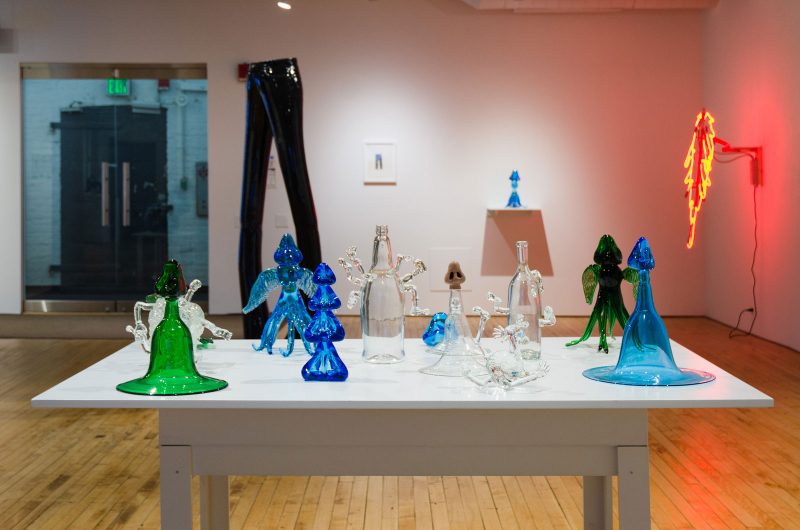
MS: There’s a lot of glass in your new work, which strikes me as an evolution in medium. On the other hand, you’ve used the shape of a glass drinking-bottle before—but rendered in felt. How did these shifts take place?
TL: Julie Courtney invited a group of us to be in a show at WheatonArts, which includes working glass-making studios and the Museum of American Glass—and that gave me an opportunity to work with master glassmakers. The approach I ended up taking was very much fueled by the Maelstrom piece and that kind of imagery. I like the alchemical nature of glassmaking—the transformation of sand in a furnace—and how glassmakers really want to “work hot” and are drawn to the furnace—like moths to light.
The glassmakers worked from my drawings. It’s easy to push a pencil or brush across the paper, but they’re working with a molten material that you can’t touch. I wanted to really collaborate with them, and we did. They mastered the lines and shapes—the hands, the feet, the clown-shoes—and added to them, not just doing what I said at first pass but taking from it and running with it. Being on hand, I could respond in an improvisational way, I could say “Let’s make a bottle, let’s grab some arms and legs and attach them.” We were able to start to sketch and draw with the glass directly.
Bottles are full of contradictions—they hold the supposed elixir, the spirits that change your consciousness for both good and bad. In art-school you hear a lot about vessels as female, but bottles seem like a male vessel form. They’re not aesthetic, they’re utilitarian—beer bottles, propane-tanks. They’re used, empty, and disposable—trash.
MS: Happy Pants is a kinetic work, but when I walk through Tiny Bangs it feels like the entire room is spinning.
TL: It feels like everything is spinning around off the walls. I was trying to get it to be active without it being kinetic. I always want everything to feel like we’re moving ahead, we’re evolving, that there’s some kind of new activity that will be sparked.
Tristin Lowe‘s “Tiny Bangs” at Fleisher/Ollman, April 11, 2019- June 1, 2019. “Emanation“, group show at Wheaton Arts and Cultural Center, April 2, 2019- December 31, 2019.
More Photos
